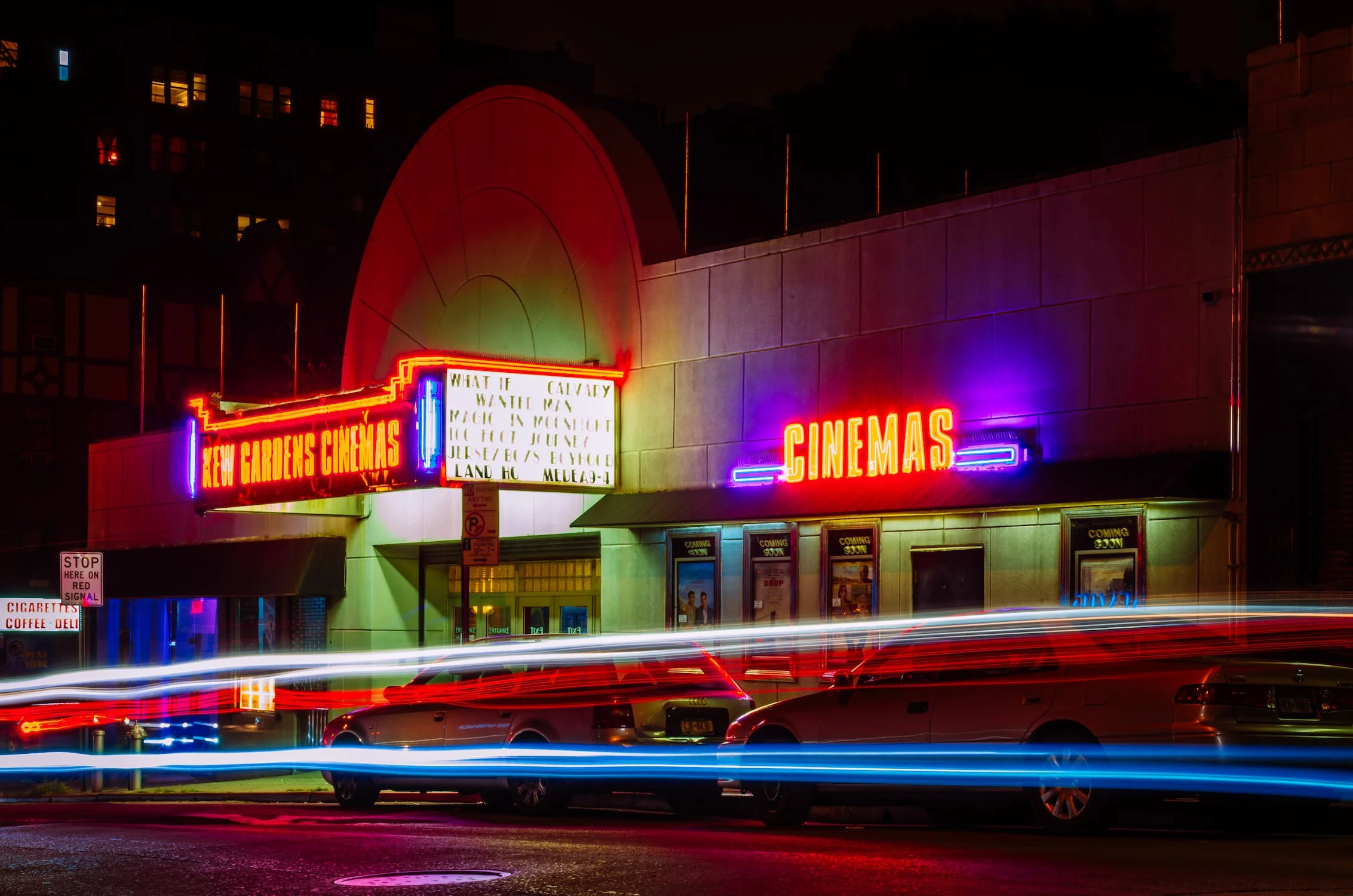14 Nov

Lights, camera, action! When it comes to advertising your brand or product, the silver screen offers a captivating platform that can’t be overlooked.
Cinema advertising has become an increasingly popular and effective way for businesses to reach their target audience in a memorable and engaging way.
Whether you’re a small local business looking to make a big impact or a global brand wanting to enhance your presence, this guide will take you through everything you need to know about cinema advertising.
From the benefits it offers to the types of ads available and tips for maximizing ROI, we’ve got you covered. So grab some popcorn and get ready for an enlightening journey into the world of cinema advertising!
What is Cinema Advertising?
Lights, camera, advertising! Cinema advertising is the art of promoting products or services through strategically placed advertisements in movie theaters. It’s a powerful marketing tool that allows businesses to showcase their offerings on the big screen, capturing the attention and imagination of a captive audience.
Unlike traditional television commercials or online ads that can be easily skipped or ignored, cinema advertising has a unique advantage – it’s virtually impossible for viewers to avoid. When people go to watch movies, they expect to see previews and advertisements before the main feature begins. This means your brand message will reach an engaged audience who are actively seeking entertainment.
Cinema advertising via media barter companies in India offers several benefits over other forms of media. It provides an immersive experience as audiences are fully engrossed in the film being shown. This heightened state of attention makes it easier for advertisements to leave a lasting impression on viewers’ minds.
Moreover, cinema ads have high recall rates due to their larger-than-life presence on the big screen combined with surround sound audio effects. Studies have shown that people tend to remember cinema ads more vividly than other types of advertising formats.
Another advantage is targeting capabilities offered by cinema advertising. By choosing specific movie genres or screening timeslots relevant to your target demographic, you can effectively reach your intended audience and maximize impact.
With various types of cinema ad formats available such as pre-roll commercials (shown before feature films), interactive displays in theater lobbies, and even branded concession stands and cup holders – there are endless possibilities for creativity in engaging with moviegoers.
In addition to reaching a wide range of consumers across different age groups and demographics at once during popular film releases, some cinemas also offer opportunities for hyperlocal targeting by allowing local businesses or events to advertise specifically within their area.
Overall,cinema advertising presents immense potential for brands looking to captivate audiences in an impactful way. So if you’re ready for lights out on your competition and want your brand message projected onto screens everywhere, it’s time to consider the power of cinema advertising.
The Benefits of Cinema Advertising
Cinema advertising offers a range of benefits that can help businesses reach their target audience in a unique and impactful way. One of the key advantages is the captive audience that cinemas provide. When people go to the movies, they are fully engaged and focused on what’s happening on the big screen. This means that your ads have a higher chance of getting noticed compared to other forms of advertising where viewers can easily switch channels or skip through content.
Another benefit is the ability to target specific demographics. With cinema advertising, you can choose which movies to advertise before based on their genre or rating, allowing you to tailor your message to reach your ideal customers. For example, if you’re promoting a new sports drink, you could place your ad before an action-packed sports movie.
Additionally, cinema ads have a larger-than-life impact due to their size and immersive experience. The sheer scale of the screen combined with surround sound creates a memorable viewing experience for audiences. This makes it easier for your brand message or product offerings to stick in their minds long after they’ve left the theater.
Furthermore, cinema advertising has minimal distractions compared to other platforms like television or online media where viewers are bombarded with multiple ads at once. In theaters, there are no commercial breaks interrupting the flow of content, allowing your ad ample time and attention from moviegoers.
Cinema advertisements provide an opportunity for creativity and storytelling. With longer runtimes available than traditional TV commercials, brands can develop narratives or showcase visually stunning imagery that captivates audiences even more effectively.
In conclusion | Overall | Finally (Please disregard) , cinema advertising offers several advantages including capturing a captive audience’s attention , targeting specific demographics , creating larger-than-life impact , minimizing distractions for viewers , as well as providing opportunities for creative storytelling . By harnessing these benefits effectively , businesses can maximize their return on investment and enhance brand awareness among moviegoers
Types of Cinema Advertising
Types of Cinema Advertising
When it comes to cinema advertising, there are several different types that brands can utilize to reach their target audience. Each type has its own unique advantages and considerations. Let’s take a closer look at some of the most common types:
1. Pre-roll Ads: These ads play before the feature film begins and typically last between 15-30 seconds. They are a great way to capture the attention of moviegoers while they are eagerly waiting for the main event.
2. On-screen Display Ads: Often displayed during intermissions or before the start of a movie, these static or animated ads appear on screen for a brief period of time. They provide an excellent opportunity for brands to showcase their products or services in a visually appealing manner.
3. Lobby Displays: Placed strategically in theater lobbies, these displays allow advertisers to engage with moviegoers as they wait in line for tickets or concessions. From interactive kiosks to large digital screens, lobby displays offer high visibility and potential customer interaction.
4. Sponsorships: This type involves partnering with cinemas or specific films to gain brand exposure throughout various marketing materials such as trailers, posters, tickets, and even special events related to the movie release.
5. In-seat Advertising: With this type of advertising, messages are placed directly in front of each seat within the theater auditorium itself – often on cup holders or seat-backs – ensuring maximum visibility during the entire viewing experience.
By understanding these different types of cinema advertising options available, brands can choose what aligns best with their objectives and budgetary constraints while effectively reaching their target audience when they’re most receptive – enjoying movies! So if you’re considering cinema advertising as part of your marketing strategy, be sure to explore all available options and select those that will help you achieve your goals seamlessly.
Steps to Creating a Successful Cinema Ad Campaign
Creating a successful cinema ad campaign requires careful planning and strategic execution. Here are some essential steps to consider:
1. Define your objectives: Start by outlining what you aim to achieve with your cinema advertising campaign. Whether it’s increasing brand awareness, driving sales, or promoting a new product, clearly defining your goals will guide all subsequent decisions.
2. Know your audience: Understanding the demographics and preferences of the cinema-goers you want to target is crucial. Conduct market research to gain insights into their interests, behaviors, and media consumption habits.
3. Craft compelling content: Develop creative and engaging advertisements that resonate with your target audience. Consider the unique environment of the movie theater and create captivating visuals and messages that capture attention amidst the big screen experience.
4. Choose the right theaters: Selecting the appropriate cinemas for displaying your ads is vital for reaching your desired audience effectively. Research different theaters’ locations, footfall numbers, screening schedules, and genres to ensure maximum exposure.
5. Optimize timing: Timing can greatly impact an ad’s effectiveness in capturing viewers’ attention. Coordinate your campaigns with major movie releases or peak attendance periods to maximize visibility among a larger audience.
6. Monitor performance: Track key metrics such as impressions, click-through rates (if applicable), brand recall, and overall campaign success rate regularly throughout its duration. This data will help evaluate performance and make necessary adjustments as needed.
7. Establish partnerships: Collaborating with film distributors or production companies can provide opportunities for cross-promotion or exclusive tie-ins that enhance both parties’ reach while adding value for consumers.
Remember that creating a successful cinema ad campaign involves continuous refinement based on data analysis and consumer feedback.
Tips for Maximizing ROI with Cinema Advertising
1. Know your audience: Before creating a cinema ad campaign, it’s crucial to understand who you’re targeting. Research the demographics of moviegoers in your target area and align your messaging accordingly.
2. Create compelling content: In a dark theater, where attention spans can be limited, it’s important to grab viewers’ attention within seconds. Craft an engaging and visually striking ad that tells a story or evokes emotion.
3. Utilize sound design effectively: Sound plays a significant role in cinema advertising. Invest in high-quality audio production to ensure that your message resonates with the audience and complements the visuals seamlessly.
4. Choose the right placement: Consider which movies attract your target demographic and select theaters accordingly. Additionally, explore opportunities for pre-show advertising or sponsorship of specific events or screenings.
5. Offer incentives or promotions: Make use of the captive audience by offering exclusive discounts or promotions available only through cinema ads. This will not only drive immediate actions but also create buzz among moviegoers.
6. Track and analyze results: Implement tracking mechanisms to monitor the effectiveness of your cinema ad campaign accurately. Analyze data such as ticket sales, website traffic, or social media engagement to gauge ROI accurately.
7. Partner with local businesses or complementary brands: Collaborating with other businesses allows you to expand reach while sharing costs associated with cinema advertising campaigns. Identify partners whose products/services complement yours for maximum impact.
8. Nurture brand recall through repetition: Consistency is key when it comes to building brand recall among moviegoers exposed to multiple ads during their visit to the theater complex.
Case Studies: Successful Cinema Ad Campaigns
Lights dim, the screen illuminates, and the audience is captivated. When it comes to cinema advertising, capturing attention is essential. Let’s take a closer look at some successful case studies that demonstrate the power of this medium.
In one memorable campaign, a popular beverage brand utilized cinema advertising to launch their new product. By strategically timing their ad before blockbuster movies with wide appeal, they reached a massive audience in a short period of time. The result? A significant increase in brand awareness and sales.
Another noteworthy example involves a luxury car manufacturer. Leveraging the immersive experience of watching films on the big screen, they showcased sleek footage of their latest model during previews. This approach not only generated excitement among moviegoers but also positioned the brand as synonymous with sophistication and style.
A fast-food chain took advantage of cinema advertising by creating an interactive experience for viewers. They incorporated QR codes into their ads, allowing moviegoers to scan and receive exclusive discounts or enter contests right from their seats! This innovative approach not only engaged audiences but also drove traffic to their stores.
These case studies highlight how cinema advertising can deliver impressive results when executed effectively. By understanding your target audience’s preferences and aligning your message with relevant film genres or themes, you can create impactful campaigns that leave a lasting impression.
Stay tuned for our next blog section where we explore common mistakes to avoid in cinema advertising and how you can maximize ROI on your campaigns!
Common Mistakes to Avoid in Cinema Advertising
When it comes to cinema advertising, there are a few common mistakes that many advertisers make which can hinder the success of their campaigns. By being aware of these pitfalls and avoiding them, you can ensure that your cinema ads have the maximum impact on your target audience.
One common mistake is not understanding the demographics of the moviegoers. It’s crucial to research and understand who typically attends movies at specific theaters before creating your ad. Without this knowledge, you may end up targeting the wrong audience with your message.
Another mistake is having a poorly defined call-to-action (CTA). Your CTA should be clear, concise, and compelling. Be sure to include relevant information such as website or contact details so that viewers know how to take action after seeing your ad.
Lack of creativity is another pitfall in cinema advertising. In a darkened theater full of captivating visuals on-screen, you need an ad that stands out from the rest. Don’t be afraid to think outside the box and create something unique and memorable.
Timing is also important when it comes to running cinema ads. Avoid scheduling your ads during peak times when audiences might be distracted or less receptive to advertisements. Instead, aim for slots where viewers are more likely engaged and attentive.
Neglecting measurement and tracking is a big mistake in any advertising campaign including cinema advertising. By monitoring key metrics like reach, frequency, conversions or engagement levels throughout your campaign period helps optimize performance effectively.
By avoiding these common mistakes in cinema advertising campaigns will help ensure better results for brands seeking exposure through this powerful medium
Future of Cinema Advertising: Opportunities and Challenges
The future of cinema advertising is filled with both opportunities and challenges. With advancements in technology and changing consumer habits, advertisers need to adapt their strategies to stay relevant in this dynamic industry.
One major opportunity for cinema advertising lies in the development of immersive experiences. As virtual reality (VR) becomes more mainstream, advertisers can create interactive ads that transport viewers into a whole new world. Imagine watching a movie preview where you can actually step inside the scene and feel like you’re part of the action. This level of engagement has the potential to leave a lasting impression on audiences.
Another opportunity arises from data-driven targeting. By leveraging audience insights and preferences, advertisers can deliver highly personalized ads that resonate with specific demographic groups or even individuals. This targeted approach increases the likelihood of capturing attention and driving conversion rates.
However, along with these opportunities come challenges. One such challenge is the rise of streaming platforms like Netflix and Amazon Prime Video, which offer ad-free viewing experiences. Advertisers will need to find innovative ways to reach audiences who prefer these streaming services while still maintaining their presence in traditional cinemas.
Additionally, there is an ongoing debate about ad fatigue among consumers. With increased exposure to advertisements across multiple channels, viewers may become desensitized or annoyed by excessive ads during movies. Striking a balance between effective promotion and audience satisfaction will be crucial for cinema advertisers moving forward.
In conclusion (!), the future holds immense potential for cinema advertising if brands are willing to embrace emerging technologies and adapt their strategies accordingly. By capitalizing on immersive experiences, leveraging data-driven targeting, finding new avenues beyond traditional cinemas, and addressing concerns around ad fatigue, advertisers can continue to captivate audiences through captivating storytelling on the big screen!
Conclusion
Cinema advertising offers a unique and powerful way for brands to connect with audiences. It allows businesses to reach a captive audience in an immersive environment, creating memorable experiences that can drive brand awareness, engagement, and ultimately sales.
Throughout this guide, we have explored what cinema advertising is and the benefits it offers. We have learned about the different types of cinema advertising available, from pre-show ads to on-screen integrations. We have also discussed the steps involved in creating a successful cinema ad campaign and provided tips for maximizing ROI.
Furthermore, we analyzed case studies of successful cinema ad campaigns that demonstrate the effectiveness of this medium when executed strategically. From Coca-Cola’s innovative interactive ads to Audi’s captivating storytelling approach, these examples highlight how cinema advertising can leave a lasting impression on viewers.
However, it is important to be mindful of common mistakes that can hinder the success of your cinema ad campaign. By avoiding issues such as poor targeting or lackluster creative content, you can ensure your investment yields optimal results.
Looking ahead, the future of cinema advertising presents both opportunities and challenges. With advancements in technology and changing consumer behaviors, advertisers must adapt their strategies accordingly. Embracing digital integration within cinemas and exploring new formats like virtual reality will be crucial for staying relevant in this ever-evolving landscape.
In conclusion (without using those exact words), cinema advertising remains an impactful marketing tool capable of delivering impressive results when utilized effectively. By understanding its potential benefits, following best practices outlined in this guide, and keeping pace with industry developments, businesses can leverage the power of the big screen to captivate audiences, build brand recognition, and drive business growth. So lights up! It’s time for your brand to shine on the silver screen through compelling and memorable cinematic experiences.
Related Post
Tags
Recent Posts
- Barter in Digital Advertising: Creative Ways to Trade Inventory for Impact
- AI-Powered Media Planning: How Marketers Can Maximize ROI
- Maximizing Your Outdoor Media Strategies for Ultimate Impact
- How to Create Detailed Buyer Personas for Your Business
- In Light of the Transparency Debate, What Are Media Barter Agencies?



